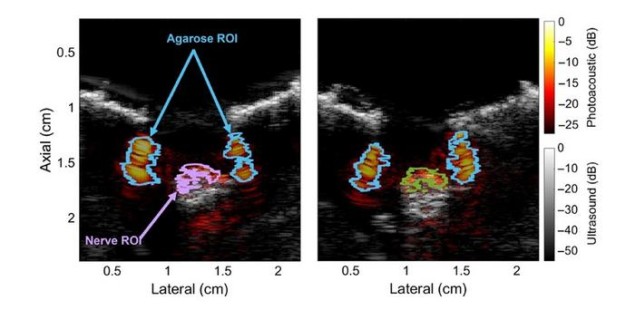
During surgery, nerves can be accidentally cut, stretched or compressed if the surgeon mistakes them for other tissue. To reduce this risk, scientists seek to develop new medical imaging techniques that are better than ultrasound and quicker than magnetic resonance imaging (MRI) at distinguishing nerve tissue and thus preventing accidental damage. Researchers at Johns Hopkins University in the US recently contributed to this effort by characterizing the optical absorption properties of an intact nerve and using this information to optimize optics-based imaging and sensing technologies.
Unlike some other tissue types, nerve tissue is rich in fatty compounds known as lipids. These lipids absorb light in two regions of the electromagnetic spectrum: the near-infrared-II (NIR-II) and near-infrared-III (NIR-III), which run from 1000–1350 nm and from 1550–1870 nm respectively. However, their strongest absorption lies in the NIR-III region, which makes these wavelengths ideal for obtaining images of lipid-rich tissues such as nerves using a hybrid method known as photoacoustic imaging.
In this method, a tissue sample is first illuminated with pulsed light, which causes it to heat up slightly. As it heats up, the tissue expands, generating ultrasonic waves that can then be detected with an ultrasound detector.
Characteristic light absorption peak
In the new work, a Johns Hopkins team led by biomedical engineer Muyinatu Bell set out to determine the best wavelength within this NIR-III window for identifying nerve tissue in photoacoustic images. The researchers hypothesized that the ideal wavelength would be between 1630 and 1850 nm, since the myelin sheath of nerve cells has a characteristic light absorption peak in this range.
To test their hypothesis, they used a standard spectrophotometer to obtain detailed optical absorption measurement on peripheral nerve samples taken in vivo from pigs. They then characterized the photoacoustic profiles of the samples by selecting amplitude information from photoacoustic images of the nerves.
The researchers initially observed an absorption peak at 1210 nm, which lies in the NIR-II range. However, this peak is also present in other types of lipids, not just the ones found in the myelin sheaths of nerve tissue, so they deemed it unsuitable for their purposes. Then, when they subtracted the contribution of water from the absorption spectrum, they found a characteristic lipid absorption peak for each of the nerves at 1725 nm – bang in the middle of the expected NIR-III range.

Deep learning accelerates super-resolution photoacoustic imaging
“Our work is the first to characterize the optical absorbance spectra of fresh swine nerve samples using a wide spectrum of wavelengths,” Bell says. “Our results highlight the clinical promise of multispectral photoacoustic imaging as an intraoperative technique to determine the presence of myelinated nerves or prevent nerve injury during medical interventions, with possible implications for other optics-based technologies.”
The researchers plan to build on their findings to design new photoacoustic imaging techniques. “We now have a nerve-specific optical absorption baseline profile that can be used in future investigations,” Bell tells Physics World. “We no longer need to rely on the spectra of lipids, which can vary.”
Their present work is detailed in Journal of Biomedical Optics.
- SEO Powered Content & PR Distribution. Get Amplified Today.
- PlatoData.Network Vertical Generative Ai. Empower Yourself. Access Here.
- PlatoAiStream. Web3 Intelligence. Knowledge Amplified. Access Here.
- PlatoESG. Carbon, CleanTech, Energy, Environment, Solar, Waste Management. Access Here.
- PlatoHealth. Biotech and Clinical Trials Intelligence. Access Here.
- Source: https://physicsworld.com/a/photoacoustic-imaging-technique-could-reduce-nerve-damage-during-surgery/
- :has
- :is
- :not
- $UP
- 10
- 160
- 28
- 9
- a
- accelerates
- accidental
- AL
- also
- an
- and
- ARE
- AS
- At
- Baseline
- BE
- Bell
- BEST
- Better
- between
- biomedical
- build
- by
- CAN
- causes
- Cells
- characteristic
- characterize
- characterized
- Clinical
- contributed
- contribution
- could
- Cut
- damage
- deemed
- Design
- detailed
- detected
- Determine
- develop
- during
- E&T
- each
- effort
- engineer
- expands
- expected
- findings
- First
- first time
- For
- found
- fresh
- from
- future
- generating
- graham
- Have
- Highlight
- hopkins
- However
- http
- HTTPS
- Hybrid
- ideal
- identifying
- if
- image
- images
- Imaging
- implications
- in
- In other
- information
- initially
- interest
- interventions
- Investigations
- issue
- IT
- johns
- Johns Hopkins University
- jpg
- just
- known
- learning
- Led
- left
- lies
- light
- longer
- MAKES
- max-width
- measurement
- medical
- method
- Microscopy
- Middle
- mistakes
- MRI
- Need
- New
- no
- now
- obtain
- obtaining
- of
- on
- ones
- Optimize
- or
- Other
- out
- outlines
- Peak
- Physics
- Physics World
- plan
- plato
- Plato Data Intelligence
- PlatoData
- possible
- presence
- present
- prevent
- preventing
- Profile
- Profiles
- promise
- properties
- purposes
- quicker
- range
- recently
- recorded
- reduce
- region
- regions
- rely
- researchers
- resonance
- respectively
- Results
- Rich
- right
- Risk
- ROI
- Run
- scientists
- Seek
- selecting
- set
- shown
- since
- So
- some
- Spectrum
- standard
- strongest
- such
- surgeon
- Surgery
- Surrounding
- taken
- team
- technique
- techniques
- Technologies
- tells
- test
- than
- that
- The
- their
- Them
- then
- These
- they
- this
- thumbnail
- Thus
- time
- to
- true
- two
- types
- university
- us
- used
- using
- Water
- waves
- WELL
- were
- when
- which
- wide
- window
- with
- within
- Work
- world
- would
- zephyrnet













